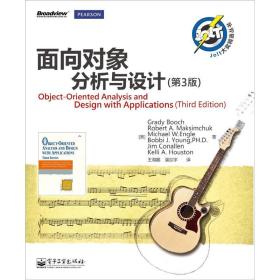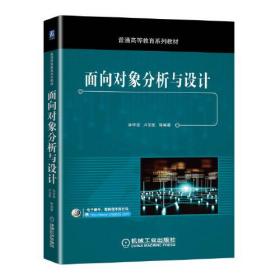
面向对象分析与设计(第3版)(英文版)
¥ 35 3.9折 ¥ 89 全新
仅1件
北京昌平
认证卖家担保交易快速发货售后保障
作者[美]布奇 著
出版社人民邮电出版社
出版时间2008-04
版次1
装帧精装
上书时间2022-05-06
- 在售商品 暂无
- 平均发货时间 25小时
- 好评率 暂无
- 店主推荐
- 最新上架
商品详情
- 品相描述:全新
- 全新硬精装
图书标准信息
- 作者 [美]布奇 著
- 出版社 人民邮电出版社
- 出版时间 2008-04
- 版次 1
- ISBN 9787115173065
- 定价 89.00元
- 装帧 精装
- 开本 16开
- 纸张 胶版纸
- 页数 691页
- 字数 959千字
- 【内容简介】
-
本书是UML创始人Grady Booch的代表作之一,书中介绍的概念都基于牢固的理论基础。同时,本书又是一本注重实效的书,面向架构师和软件开发者等软件工程实践者的实际需要。本书通过大量例子说明了基本概念,解释了方法,并展示了在不同领域的成功应用。全书分为理论和应用两部分。理论部分深刻剖析了面向对象分析与设计(OOAD)的概念和方法。应用部分连续列出了5个不同类型、不同领域的应用,描述如何从初始阶段到移交阶段将OOAD理论和方法应用到项目中。应用部分所涉及的领域包括系统架构、数据获取、密码分析、控制系统和Web开发,还给出了一些关于重要问题的有效建议,包括分类、实现策略和高性价比的项目管理。书中的表示法采用最新的UML 2.0,因此本书是学习UML 2.0不可多得的参考书。
本书作者基于长期丰富的经验,提出了改进的对象开发方法,用于解决系统和软件开发者面临的复杂问题,非常适合实际系统和软件的开发者、系统分析师或构架师、项目经理阅读。本书主要阐述了软件开发的方法,也可以作为高等院校软件工程和高级编程课程的教材使用。 - 【作者简介】
- 布奇(Grady Booch)是IBM院士(IBM fellow)和6本面向对象编程畅销书的作者。他是世界知名的面向对象技术发起人和UML创始人之一。
- 【目录】
-
Section Ⅰ Concepts
Chapter 1 Complexity
1.1 The Structure of Complex Systems
1.2 The Inherent Complexity of Software
1.3 The Five Attributes of a Complex System
1.4 Organized and Disorganized Complexity
1.5 Bringing Order to Chaos
1.6 On Designing Complex Systems
Chapter 2 The Object Model
2.1 The Evolution of the Object Model
2.2 Foundations of the Object Model
2.3 Elements of the Object Model
2.4 Applying the Object Model
Chapter 3 Classes and Objects
3.1 The Nature of an Object
3.2 Relationships among Objects
3.3 The Nature of a Class
3.4 Relationships among Classes
3.5 The Interplay of Classes and Objects
3.6 On Building Quality Classes and Objects
Chapter 4 Classification
4.1 The Importance of Proper Classification
4.2 Identifying Classes and Objects
4.3 Key Abstractions and Mechanisms
Section Ⅱ Method
Chapter 5 Notation
5.1 The Unified Modeling Language
5.2 Package Diagrams
5.3 Component Diagrams
5.4 Deployment Diagrams
5.5 Use Case Diagrams
5.6 Activity Diagrams
5.7 Class Diagrams
5.8 Sequence Diagrams
5.9 Interaction Overview Diagrams
5.10 Composite Structure Diagrams
5.11 State Machine Diagrams
5.12 Timing Diagrams
5.13 Object Diagrams
5.14 Communication Diagrams
Chapter 6 Process
6.1 First Principles
6.2 The Macro Process: The Software Development Lifecycle
6.3 The Micro Process: The Analysis and Design Process
Chapter 7 Pragmatics
7.1 Management and Planning
7.2 Staffing
7.3 Release Management
7.4 Reuse
7.5 Quality Assurance and Metrics
7.6 Documentation
7.7 Tools
7.8 Special Topics
7.9 The Benefits and Risks of Object-Oriented Development
Section Ⅲ Applications
Chapter 8 System Architecture: Satellite-Based Navigation
8.1 Inception
8.2 Elaboration
8.3 Construction
8.4 Post-Transition
Chapter 9 Control System: Traffic Management
9.1 Inception
9.2 Elaboration
9.3 Construction
9.4 Post-Transition
Chapter 10 Artificial Intelligence: Cryptanalysis
10.1 Inception
10.2 Elaboration
10.3 Construction
10.4 Post-Transition
Chapter 11 Data Acquisition: Weather Monitoring Station
11.1 Inception
11.2 Elaboration
11.3 Construction
11.4 Post-Transition
Chapter 12 Web Application: Vacation Tracking System
12.1 Inception
12.2 Elaboration
12.3 Construction
12.4 Transition and Post-Transition
Appendix A Object-Oriented Programming Languages
A.1 Language Evolution
A.2 Smalltalk
A.3 C++
A.4 Java
Appendix B Further Reading
Notes
Glossary
Classified Bibliography
Index
点击展开
点击收起
相关推荐
— 没有更多了 —




























以下为对购买帮助不大的评价